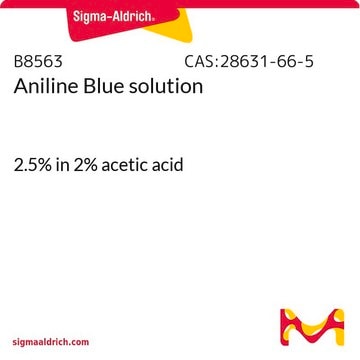E8886
Erythrosin extra bluish
Dye content, ≥80%, certified by the Biological Stain Commission, powder
Synonym(s):
2′,4′,5′,7′-Tetraiodofluorescein disodium salt, Acid Red 51, Iodoeosin
About This Item
Recommended Products
product name
Erythrosin extra bluish, certified by the Biological Stain Commission
grade
certified by the Biological Stain Commission
form
powder
composition
Dye content, ≥80%
pH
6.4 (30.3 °C)
mp
315 °C
solubility
water: 1 mg/mL, clear
density
0.625-0.731 g/cm3 at 30.1 °C
application(s)
diagnostic assay manufacturing
hematology
histology
storage temp.
room temp
SMILES string
[Na+].[Na+].[O-]c1c(I)cc2c(Oc3c(I)c([O-])c(I)cc3C24OC(=O)c5ccccc45)c1I
InChI
1S/C20H8I4O5.2Na/c21-11-5-9-17(13(23)15(11)25)28-18-10(6-12(22)16(26)14(18)24)20(9)8-4-2-1-3-7(8)19(27)29-20;;/h1-6,25-26H;;/q;2*+1/p-2
InChI key
RAGZEDHHTPQLAI-UHFFFAOYSA-L
Looking for similar products? Visit Product Comparison Guide
General description
Suitability
Signal Word
Warning
Hazard Statements
Precautionary Statements
Hazard Classifications
Acute Tox. 4 Oral - Aquatic Chronic 2
Storage Class Code
11 - Combustible Solids
WGK
WGK 1
Flash Point(F)
359.6 °F - closed cup
Flash Point(C)
182 °C - closed cup
Personal Protective Equipment
Certificates of Analysis (COA)
Search for Certificates of Analysis (COA) by entering the products Lot/Batch Number. Lot and Batch Numbers can be found on a product’s label following the words ‘Lot’ or ‘Batch’.
Already Own This Product?
Find documentation for the products that you have recently purchased in the Document Library.
Customers Also Viewed
Our team of scientists has experience in all areas of research including Life Science, Material Science, Chemical Synthesis, Chromatography, Analytical and many others.
Contact Technical Service















